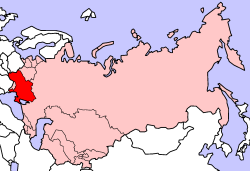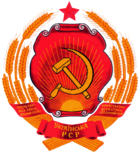Ukrainian Soviet Socialist Republic
| Українська Радянська Соціалістична Республіка (Ukrainian) Украинская Советская Социалистическая Республика (Russian) Ukrainian Soviet Socialist Republic |
|||||
|
|||||
|
|||||
 |
|||||
| Capital | Kharkiv (1917-1918 and 1919-1934) Kiev (1934-1991) [1] |
||||
| Official language | Ukrainian and Russian | ||||
| Established In the USSR: - Since - Until |
December 25, 1917 December 30, 1922 August 24, 1991 |
||||
| Area - Total - Water (%) |
Ranked 3rd in the USSR 603,700 km² negligible |
||||
| Population - Total - Density |
Ranked 2nd in the USSR 51,706,746 (1989) 85.6/km² |
||||
| Time zone | UTC + 3 | ||||
| Anthem | Anthem of Ukrainian SSR | ||||
| Medals | |||||
The Ukrainian Soviet Socialist Republic or the Ukrainian SSR was one of the founder of the USSR and Republic that made up the former Soviet Union from its formation in 1922 to its abolishment in 1991.
Contents |
Name
The first Bolshevik republic declared in December 1917 was called the Soviet Republic of Ukraine (Respublyka Rad Ukrayiny).
The third Bolshevik republic of December 1919 was known as the Ukrainian Socialist Soviet Republic. Its Ukrainian initials were УРСС (URSS).
In 1937, the republic's name was changed again, per new Constitution adopted, c along with the names of all other Soviet republics, transposing the second and third words. It would be known from 1937–91 as the Ukrainian Soviet Socialist Republic, abbreviated Ukrainian SSR, UkrSSR, or UkSSR.
The official names in Ukrainian and Russian were:
- Ukrainian: Українська Радянська Соціалістична Республіка (УРСР), Ukrayins’ka Radyans’ka Sotsialistychna Respublika (URSR)
- Russian: Украинская Советская Социалистическая Республика (УССР), Ukrainskaya Sovetskaya Sotsialisticheskaya Respublika (USSR)
History
After the break-up of the Russian Empire, several factions sought to create an independent Ukrainian state, alternately co-operating and struggling against each other. Ukrainian Bolsheviks and Mensheviks first participated in the formation of the Ukrainian National Republic (UNR), which initially declared autonomy in 1917, and then independence in 1918.


The Bolsheviks favoured federation with Russia, but lacking broad popular support within Central Ukraine but supported at industrial centres of East Ukraine, convened a separate congress and declared the first Soviet Republic of Ukraine on December 25, 1917. Warfare ensued against the UNR, and a series of alliances and conflicts with anarchists and neo-haydamak bands. After failed first stage of the Treaty of Brest-Litovsk Central_Powers forces captured all almost all Ukrainian territory and Ukrainian Bolsheviks being pushed out of Ukraine altogether, and having the government dissolved for two interludes lasting several months (being reformed on November 20, 1918, and December 21, 1919). Eventually, with the support of the Red Army and local Anarchists, the Ukrainian SSR ended up controlling much of Ukrainian territory after the Polish-Soviet Peace of Riga.
On December 30, 1922, along with the Russian, Byelorussian, and Transcaucasian republics, the Ukrainian SSR was one of the founding members of the Union of Soviet Socialist Republics (USSR).
In 1932 the government inflicted one of the largest national catastrophes in modern history of the Ukrainian nation. A man-made famine known as the Holodomor caused a direct loss of human life estimated between 2.6 and 3.5 million, while numbers as high as 10 million are sometimes cited in the media.[2]
In September 1939 the Soviet Union invaded Poland, and added Galician lands inhabited by Ukrainians to the territory of the Ukrainian SSR. In 1945, these lands were permanently annexed, and the Transcarpathia region was added as well, by treaty with the post-war administration of Czechoslovakia.
After World War II some amendments to the Constitution of the Ukrainian SSR were accepted, which allowed it to act as a separate subject of international law in some cases and to a certain extent, remaining a part of the Soviet Union at the same time. In particular, these amendments allowed the Ukrainian SSR to become one of founding members of the United Nations (UN) together with the Soviet Union and the Byelorussian SSR.
The Ukrainian SSR was also the site of the Chernobyl disaster in 1986, when a reactor at the Chernobyl Nuclear Power Plant melted down and exploded, subjecting countless multitudes to radiological effects.
The Ukrainian SSR was officially renamed Ukraine on August 24, 1991. It declared its intention of leaving the Soviet Union the same day, and on December 25, 1991 became fully independent following the dissolution of the Soviet Union.

Leaders of the Ukrainian SSR
Terms of the leaders of the Communist Party (Bolshevik) of Ukraine, and de facto leaders of the republic:
- Georgy Pyatakov, 1918
- Stanislav Kosior, 1919–1920
- Dmitry Manuilsky, 1921–1923
- Emmanuil Kviring, 1923–1925
- Lazar Kaganovich, 1925–1928
- Stanislav Kosior, 1928–1938
- Nikita Khrushchev, 1938–1947
- Lazar Kaganovich, 1947
- Nikita Khrushchev, 1947–1949
- Leonid Melnikov, 1949–1953
- Alexei Kirichenko, 1953–1957
- Nikolai Podgorny, 1957–1963
- Petro Shelest, 1963–1972
- Volodymyr Shcherbytsky, 1972–1989
- Vladimir Ivashko, 1989–1990
- Stanislav Gurenko, 1990–1991
Administrative divisions
|
The administrative divisions of the Ukrainian SSR changed numerous times throughout its 74-year history. The most common administrative division was the oblast (province) of which there were 25 upon the UkSSR's abolishment in 1991. Most of the UkSSR's oblasts still exist to this day as part of independent Ukraine while one changed its status to an autonomopus republic. (see map).
Upon the Ukrainian SSR's formation to 1934, the republic's capital was the city of Kharkiv (Rus. Kharkov) located in the east of the republic. In 1934, the capital was moved from Kharkiv to Kiev (Ukr. Kyiv), which remains the capital of Ukraine today.
Other administrative divisions of the Ukrainian SSR included the two Autonomous Soviet Socialist Republics which existed during different time periods. The Moldavian Autonomous Soviet Socialist Republic existed from 1924-1940 until it was upgraded to that of a constituent Soviet republic in 1940.
The other ASSR was the Crimean Autonomous Soviet Socialist Republic which was formed in 1991 from the former Crimean Oblast, which was transferred to the Ukrainian SSR from the Russian SFSR in 1954. After Ukrainian independence, the Crimean ASSR was renamed the Crimean Autonomous Republic.
Oblasts
|
|
References
- ↑ Радя́нська енциклопе́дія істо́рії Украї́ни in 4 volumes Kyiv 1969-72 Academy of Science of UKR SSR
- ↑ Laura Sheeter, "Ukraine remembers famine horror", BBC News, November 24, 2007
External links
- "Governments of the Ukrainian Soviet Socialist Republic" (in Enslish). Government portal. Retrieved on 2008-06-11.
- "Constitution of the Ukrainian Soviet Socialist Republic" (in Ukrainian). Verkhovna Rada of Ukraine (1978). Retrieved on 2008-06-11.
|
||||||||||


